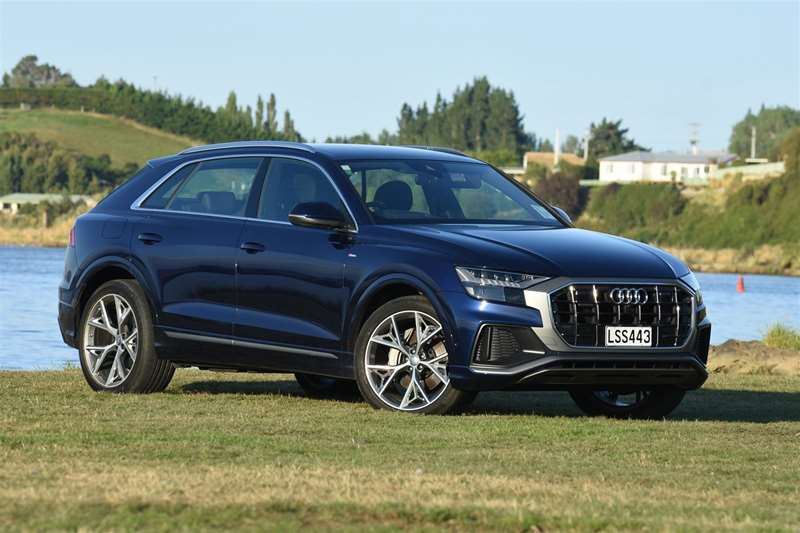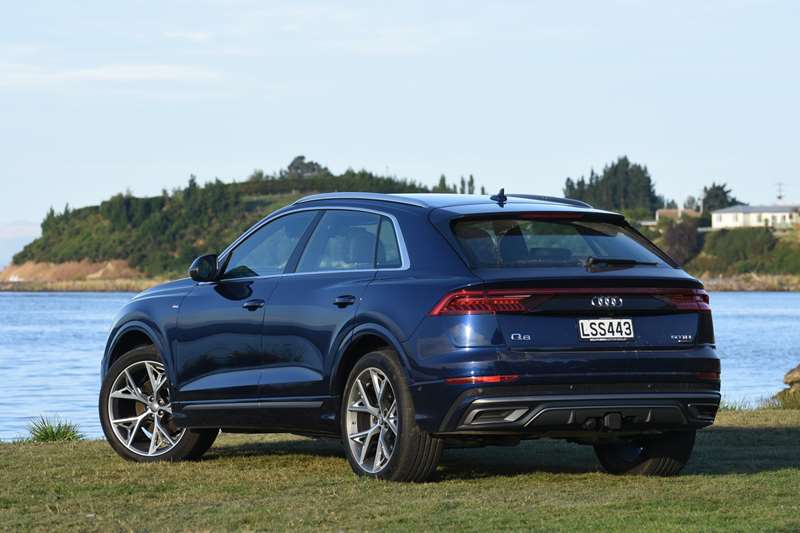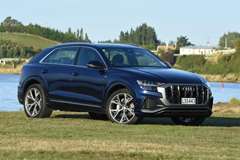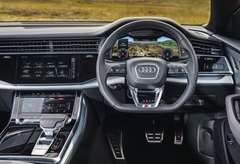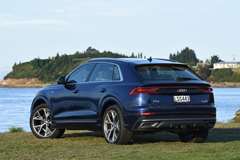David Thomson takes the new Audi SUV for a spin and discovers that, although late to the party, the Q8 is up there with the very best of its rivals.
LARGE coupe-like SUVs have been around for some time now, BMW having started down this path with the X6 back in 2008, and Mercedes-Benz chipping in from 2015 with the GLE Coupe. Where BMW and Mercedes-Benz go, Germany’s third luxury marque, Audi, is pretty much obliged to follow, which is why the latest edition of the more conventional Q7 luxury SUV now has a stylish coupe sibling, the Q8.
Although using the same underlying platform as the Q7, the Q8 can claim structural kinship with the new Bentley Bentagya, Lamborghini Urus and the latest iteration of the Porsche Cayenne; yes, SUVs have become truly ubiquitous, even at the ultra-premium high-performance end of the new-car market.
At the same time, the Q8 is very much its own machine, and a significant one for Audi.
It’s the first Audi SUV developed with the company’s new design chief Marc Lichte at the helm. It introduces a new look — of which the prominent octagonal grille flanked by matrix LED headlights is the most obvious feature — that will gradually be adopted by other sports utilities in the Audi range.
Slightly shorter, lower and fractionally wider than the Q7, the Q8 treads a familiar large coupe SUV path in that it sheds some luggage capacity and a third row of seats in favour of style. Yet its proportions and exterior lines, while far sportier than the Q7, are more balanced and conventionally elegant than the exaggerated coupe swoops and swerves of its closest rivals.
The test car gained an extra visual lift, courtesy of the S-Line exterior package and special 22-inch (rather than the usual 20-inch) v-spoke alloy wheels.
These two items alone added $19,500 to the usual $149,900 asking price for the only Q8 model available here, the Q8 50 TDI. A further $3850 worth of interior options — heated front and rear seats, quad-zone climate control, and special grey oak inlays — lifted the asking price for the test car to $173,250.
The leather-trimmed cabin is beautifully finished, and combines its luxury ambience up front with ample room and supportive, adjustable sports seats.
The dashboard is dominated by digital displays. Two of these — a primary 10.2-inch screen mounted on the centre of the dash above a smaller 8.6-inch unit — are home base for the vehicle’s multimedia infotainment system. Both are haptically-controlled touchscreens, which take a little time to learn, but are brilliant once mastered.
The upper screen provides access to all of the Q8’s MMI features and functions, including the satellite navigation, vehicle settings and telephone connectivity.
The lower screen displays the features interacted with most often, such as the air conditioning and the sound system. The other digital displays are a head up unit and Audi’s Virtual Cockpit, in which a customisable 12.3-inch widescreen replaces the traditional analogue instrument cluster.
Thanks to the plethora of digital displays and the MMI touch-and-swipe system, very few conventional knobs and buttons are required. This helps gives the front of the cabin a clean minimalist feel.
At the same time, the various screens are customisable to an impressive degree. Among the advanced display features, the exterior 3-D camera allows the driver to toggle around the vehicle when manoeuvring in tight spaces.
The Q8 also features an extensive array of active and passive safety features.
These include adaptive radar cruise control, active lane keeping and lane changing assistance, pre-sense collision mitigation systems front and rear, a cross-traffic alert system and auto-dipping headlights.
A key consideration in any coupe-styled SUV is the amount of rear cabin space and luggage room on offer.
Storage options are reasonable, although what looks like a large, deep centre bin between the front seats is, in reality, quite shallow, in part because it contains the Q8’s wireless phone charger.
Given the constraints of its roofline the Q8 does very well for rear headroom, and legroom is fine, too. Accessed by a power-operated tail gate, the boot is smaller than the Q7, yet still provides a respectable 605L. Carrying capacity can be boosted in the usual way to more than 1750L via the split-folding rear seat function.
Further and more potent engine options are on the way, but for now the sole mechanical specification for the Q8 in New Zealand is the 50 TDI. This designates the presence of 210kW/600Nm 3L turbo-diesel under the bonnet, with an eight-speed automatic transmission driving all four wheels.
The 50 TDI features Audi’s latest mild hybrid technology. This integrates a 10Ah lithium-ion battery and a belt alternator starter (BAS) with the car’s 48-volt primary electrical system to provide a regenerative stop-start function for the diesel engine that activates when the vehicle is coasting, as well as when it is stopped.
Almost imperceptible in actual operation, this set up is credited by Audi with achieving fuel savings of up to 0.7L/100km in real world conditions. Based on the 50 TDI’s standard cycle consumption figure of 6.8L/100km, this equates to about a 10% fuel consumption saving, and gives the vehicle a theoretical range of over 1200km between refills of its 85L tank.
The Q8 50 TDI combines commendable frugality and range with solid performance. While its official 0-100kmh time of 6.3 seconds is impressive for such a large and economical machine, those looking for serious grunt will likely be drawn the more powerful petrol and plug-in hybrid Q8 models that are due to follow the 50 TDI later this year.
Unsurprisingly, given that peak torque is produced from 2250-3250rpm, the 50 TDI’s most compelling mechanical attribute is its effortless response through the mid-range. When cruising this is best elicited by light pressure on the accelerator, a heavy-footed response disturbs the vehicle’s otherwise excellent mechanical refinement, and can lead to a moment of hesitation as the transmission drops down a couple of gears.
Equipped with adaptive air suspension, the test car covered a range of bases on the ride-handling spectrum. Comfort mode provides the most compliant ride, and is the obvious choice for around town motoring. There’s no escaping the sense of the Q8 being a large vehicle. That said, the Q8 has an impressively tight turning circle, due in large measure to its four-wheel steering.
At the opposite extreme in terms of driving conditions, the Q8 is possessed of far more off-road ability than the average owner is ever going to require. Ride height can be raised at the push of a button to boost ground clearance from 164mm to 254mm, and there’s a special off-road mode for the vehicle’s torque-vectoring all-wheel-drive system. Hill descent control is also standard, leaving the Q8’s road-focused tyres as the main practical impediment to serious trailblazing.
This test included a brief traverse of a firm, but badly rutted all-weather road; the Q8 covered the route with consummate ease and in great comfort.
Comfort mode is the best option for the main highway haul, enabling the Q8 to soak up surface imperfections with similar aplomb to the luxury saloons that, in times gone by, would be the usual choice for folk who now prefer large SUVs.
However, push in the direction of the more serious twists and turns that feature on all of the routes that connect coastal Otago with our inland regions, and the better choice is the vehicle’s sports-oriented dynamic mode.
Dynamic mode, at the cost of some ride absorbency, provides superior body control, and allows the Q8 to corner flatter through medium to slow-speed bands. This feature, rather than the accompanying sharpening of throttle response and gearshift protocols, is central in re-setting the feel of the Q8 when driven at pace.
Surefootedness is there in spades, along with a commendable resistance to understeer for a vehicle so large. Yet, due in part to limited steering feel, engagement between the driver, the vehicle, and the road is slightly lacking.
Audi may have been late to arrive on the coupe-like large SUV scene, but the Q8 is up there with the very best of its rivals.
